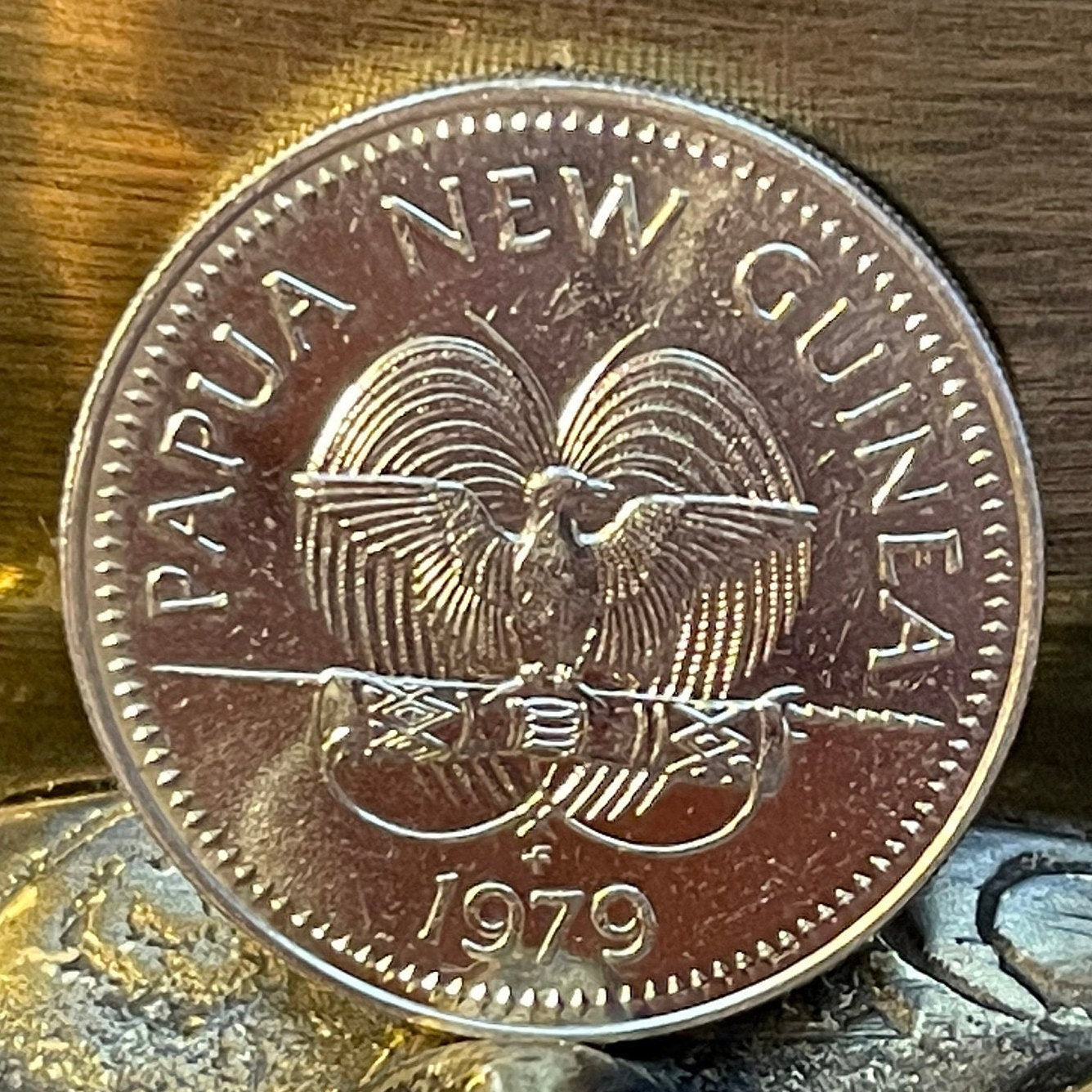elemintalshop
Dwarf Cassowary & Bird of Paradise 20 Toea Papua New Guinea Authentic Coin Money for Jewelry and Craft Making
Dwarf Cassowary & Bird of Paradise 20 Toea Papua New Guinea Authentic Coin Money for Jewelry and Craft Making
Couldn't load pickup availability
Dwarf Cassowary & Bird of Paradise 20 Toea Papua New Guinea Authentic Coin Money for Jewelry and Craft Making
Reverse: Dwarf Cassowary.
Lettering: 20t
Obverse: Coat of Arms of Papua New Guinea: a bird-of-paradise over a traditional spear and a kundu drum.
Lettering: PAPUA NEW GUINEA
Features
Issuer Papua New Guinea
Queen Elizabeth II (1975-date)
Type Standard circulation coin
Years 1975-1999
Value 20 Toea
0.2 PGK = 0.06 USD
Currency Kina (1975-date)
Composition Copper-nickel
Weight 11.3 g
Diameter 28.65 mm
Thickness 2.32 mm
Shape Round
Orientation Medal alignment ↑↑
Number N# 5271
References KM# 5
Wikipedia:
Casuarius is a genus of birds in the order Casuariiformes, whose members are the cassowaries. It is classified as a ratite (flightless bird without a keel on its sternum bone) and is native to the tropical forests of New Guinea (Papua New Guinea and Indonesia), Aru Islands, and northeastern Australia.
Three species are extant: The most common, the southern cassowary, is the third-tallest and second-heaviest living bird, smaller only than the ostrich and emu. The other two species are represented by the northern cassowary and the dwarf cassowary. A fourth but extinct species is represented by the pygmy cassowary.
Cassowaries feed mainly on fruit, although all species are truly omnivorous and take a range of other plant foods, including shoots and grass seeds, in addition to fungi, invertebrates, and small vertebrates. Cassowaries are very wary of humans, but if provoked, they are capable of inflicting serious, even fatal, injuries to both dogs and people. The cassowary has often been labeled "the world's most dangerous bird".
....The dwarf cassowary (Casuarius bennetti), also known as Bennett's cassowary, little cassowary, mountain cassowary or mooruk, is the smallest of the three species of cassowaries.
....All three species have a keratinous, skin-covered casque on their heads that grows with age. The casque's shape and size, up to 18 cm (7 in), is species-dependent. C. casuarius has the largest and C. bennetti the smallest (tricorn shape), with C. unappendiculatus having variations in between. Contrary to earlier findings, the hollow inside of the casque is spanned with fine fibres that are believed to have an acoustic function.
Several functions for the casque have been proposed. One is that they are a secondary sexual characteristic. Other suggested functions include being used to batter through underbrush, as a weapon in dominance disputes, or for pushing aside leaf litter during foraging. The latter three are disputed by biologist Andrew Mack, whose personal observation suggests that the casque amplifies deep sounds.
...The casques also may play a role in either sound reception or acoustic communication. This is related to a discovery that at least the dwarf cassowary and southern cassowary produce very-low-frequency sounds, which may aid in communication in dense rainforest. The "boom" vocalisation that cassowaries produce is the lowest-frequency bird call known, and is at the lower limit of human hearing. A cooling function for the very similar casques of guineafowl has been proposed.
The average lifespan of wild cassowaries is believed to be about 40 to 50 years.
*******
Wikipedia:
The birds-of-paradise are members of the family Paradisaeidae of the order Passeriformes. The majority of species are found in Papua New Guinea and eastern Australia. The family has 42 species in 15 genera. The members of this family are perhaps best known for the plumage of the males of the species (the majority) which are sexually dimorphic, in particular the very long elaborate feathers extending from the beak, wings, tail or head. For the most part they are confined to dense rainforest habitat. The diet of all species is dominated by fruit and to a lesser extent arthropods. The birds-of-paradise have a variety of breeding systems, ranging from monogamy to lek-type polygamy.
.....Societies of New Guinea often use bird-of-paradise plumes in their dress and rituals, and the plumes were popular in Europe in past centuries as adornment for ladies' millinery. Hunting for plumes and habitat destruction have reduced some species to endangered status; habitat destruction due to deforestation is now the predominant threat.
Best known are the members of the genus Paradisaea, including the type species, the greater bird-of-paradise, Paradisaea apoda. This species was described from specimens brought back to Europe from trading expeditions in the early sixteenth century. These specimens had been prepared by native traders by removing their wings and feet so that they could be used as decorations. This was not known to the explorers, and in the absence of information many beliefs arose about them. They were briefly thought to be the mythical phoenix. The often footless and wingless condition of the skins led to the belief that the birds never landed but were kept permanently aloft by their plumes. The first Europeans to encounter their skins were the voyagers in Ferdinand Magellan's circumnavigation of the Earth. Antonio Pigafetta wrote that "The people told us that those birds came from the terrestrial paradise, and they call them bolon diuata, that is to say, 'birds of God"." This is the origin of both the name "bird of paradise" and the specific name apoda – without feet. An alternate account by Maximilianus Transylvanus used the term Mamuco Diata, a variant of Manucodiata, which was used as a synonym for birds-of-paradise up to the 19th century.
Share










Every coin in my order is clean and just as photographed. Coins were attached to cardboard and then shipped with extra padding. Wonderful!
Excellent product and as described
cool x 15 thumbs up ⭐⭐⭐⭐⭐
My grandson is fascinated with cassowaries! He was very happy to receive this.
Beautiful coin, as described, fast shipping.









